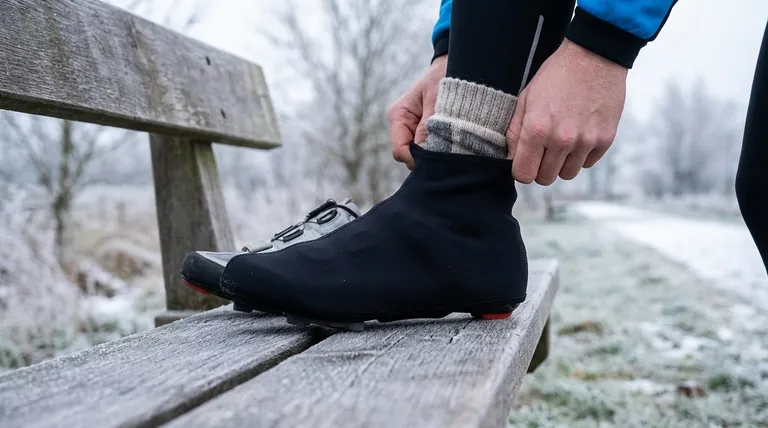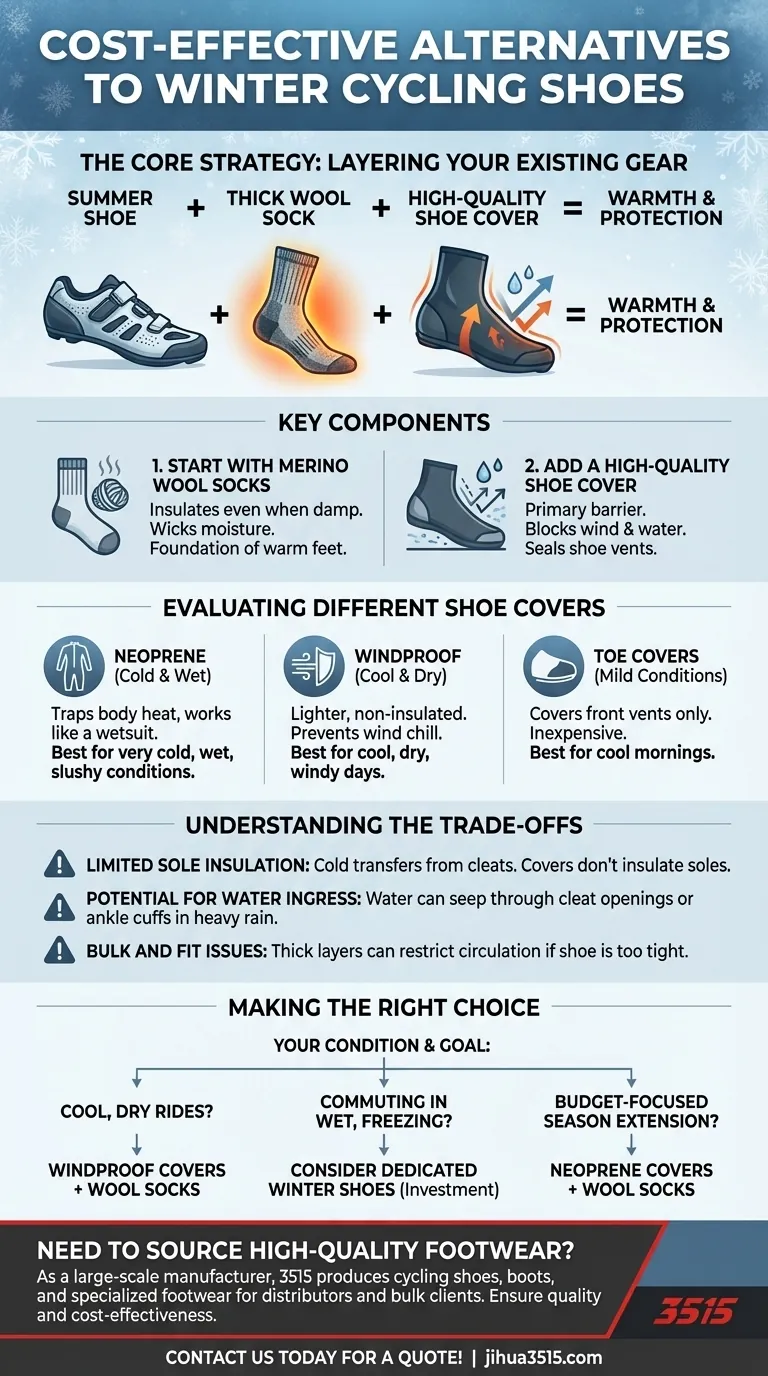For cyclists looking to ride through the cold, the most cost-effective alternatives to dedicated winter cycling shoes are a combination of thick wool socks and high-quality shoe covers. This layering strategy uses your existing summer shoes to create a surprisingly effective barrier against the elements without the significant investment in specialized winter footwear.
The core principle is simple: instead of buying a single, expensive piece of insulated gear, you create a modular system. This involves trapping heat with proper socks and blocking wind and water with an external shell.

The Core Strategy: Layering Your Existing Gear
The reason this approach works is that it directly addresses the two primary ways your feet get cold while cycling: conductive heat loss and convective heat loss from wind and moisture.
Start with the Right Socks
The foundation of warm feet is the right sock. Merino wool is the superior choice for its ability to insulate even when damp and effectively wick moisture away from your skin.
Choose a sock thickness appropriate for the temperature, but be mindful not to make your shoes so tight that you restrict blood flow, which can make your feet colder.
Add a High-Quality Shoe Cover
A shoe cover, or overshoe, is the most critical component. It slips directly over your existing cycling shoe to provide a protective shell.
Its primary job is to block the wind, which is the biggest thief of heat. Most summer cycling shoes are designed with vents for cooling, and a shoe cover effectively seals these off. Many also provide excellent water resistance.
Evaluating Different Types of Shoe Covers
Not all shoe covers are created equal. Choosing the right one depends on the conditions you plan to ride in.
Neoprene Covers for Cold and Wet
Neoprene is the warmest option, working like a wetsuit to trap air and water, which your body then warms. These are the best choice for very cold temperatures and wet or slushy conditions.
Windproof Covers for Cool and Dry
For cool, dry, and windy days, a lighter, non-insulated windproof cover is often sufficient. They offer less bulk than neoprene while still preventing the chilling effect of the wind.
Toe Covers for Mild Conditions
If you only need a small amount of protection for cool mornings, a simple toe cover is an extremely inexpensive option. It covers just the front vents of your shoe where the wind hits first.
Understanding the Trade-offs
While the sock-and-cover method is highly effective for its cost, it's important to recognize its limitations compared to dedicated winter shoes.
Limited Sole Insulation
A significant amount of cold transfers up from your metal cleats and pedals. Dedicated winter shoes (like those from Shimano, Lake, or Northwave) feature insulated soles to combat this, a feature that shoe covers cannot replicate.
Potential for Water Ingress
Even with waterproof covers, water can eventually seep in through the cleat opening on the bottom or the ankle cuff at the top during a sustained downpour. True winter boots offer a much more sealed, integrated design.
Bulk and Fit
Adding thick socks and a shoe cover can create a snug fit. If it's too tight, it can compress the insulation and restrict circulation, defeating the purpose. Dedicated winter shoes are sized to accommodate thicker socks from the start.
Making the Right Choice for Your Ride
Your decision should be based on the conditions you face most often and your tolerance for cold.
- If your primary focus is riding in cool, dry conditions above freezing: The combination of wool socks and windproof shoe covers is an excellent and highly cost-effective solution.
- If your primary focus is commuting or training through wet and near-freezing weather: A dedicated winter cycling shoe is a worthwhile investment in comfort, safety, and durability.
- If your primary focus is simply extending your season on a tight budget: Start with quality merino wool socks and add a pair of neoprene shoe covers when you can.
By understanding how to properly layer your existing gear, you can confidently extend your riding season without breaking the bank.
Summary Table:
| Alternative Component | Key Benefit | Best For |
|---|---|---|
| Merino Wool Socks | Insulates when damp, wicks moisture | Foundation for all conditions |
| Neoprene Shoe Covers | Blocks wind & water, traps heat | Cold, wet, or slushy rides |
| Windproof Shoe Covers | Blocks wind, less bulk | Cool, dry, and windy days |
| Toe Covers | Inexpensive, covers front vents | Mild conditions or cool mornings |
Need to source high-quality, affordable cycling footwear?
As a large-scale manufacturer, 3515 produces a comprehensive range of footwear for distributors, brand owners, and bulk clients. Whether you need cycling shoes, boots, or other specialized footwear, our production capabilities ensure quality and cost-effectiveness for your business.
Contact us today to discuss your production needs and get a quote!
Visual Guide

Related Products
- Premium KPU Athletic Safety Shoes for Wholesale
- Durable Rubber-Soled Utility Shoes for Wholesale & Custom Brand Manufacturing
- Wholesale Training Shoes with Dial Lacing System Custom OEM Manufacturing
- Wholesale Breathable Training Shoes Custom Athletic Footwear Manufacturer
- Premium Lightweight Safety Shoes for Wholesale & Bulk Orders
People Also Ask
- How is puncture resistance evaluated in footwear soles? Balance Protection, Comfort & Safety
- What does a green triangle symbol on safety footwear mean? Your Guide to Maximum Puncture & Impact Protection
- What are the conditions faced by employees in meatpacking and poultry slaughter plants? Navigating Pervasive Slip Hazards
- What materials are used in the construction of these boots? A Guide to Velour Leather, Textile & PU Soles
- Why is expert help recommended when selecting safety shoes? Ensure Perfect Fit & Hazard Protection



















